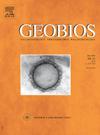新西兰早中新世St Bathans动物群概述
IF 1.6
4区 地球科学
Q2 PALEONTOLOGY
引用次数: 0
摘要
圣巴坦动物群来自南岛奥塔哥中部圣巴坦斯村附近的遗址,是在新西兰发现的第一个实质性的前第四纪陆生脊椎动物化石动物群。该动物群来自于Manuherikia群湖相Bannockburn组下50 m的33个地点或离散沉积层,通常被认为是局部阶段Altonian (19-15.9 Ma);Burdigalian,早中新世)的年代。自2001年以来的调查显示,在这里审查的9000多个目录中发现了丰富多样的动物。无脊椎动物包括8个属和种的陆生软体动物。在脊椎动物中,淡水鱼仍然占主导地位,有17种,经分析的16500块耳石(新颌属、星系属、原生动物属和Mataichthys属)和数千块骨头证明了这一点。鸟类(最少45种,数千根骨头)是最常见的非鱼类脊椎动物,其中水禽占主导地位(10种)。与这些动物共存的是各种各样的爬行动物,包括尚未确定的鳄鱼和陆龟,这两种动物在最近的动物群中都不存在。值得注意的是,圣巴桑动物群证明了西兰洲在中新世早期已经拥有新西兰所有的“古老”特有的最近分类群(蝶齿类、拟龙类、恐龙类、无翼类、无翼类、反射类鹦鹉、棘齿类和神秘类)。此外,它还包括澳大拉西亚最古老的犰狳、两种不会飞的蜥蜴、一种新的高等陆鸟科、种类更丰富的蝙蝠和陆生哺乳动物。除了湖鸭(Manuherikia lakuina)(剖面地层较低)和原鸭(M. primadiuua)(剖面较高)具有相互排斥的分布,尚未与任何其他生物分布差异相关外,所有遗址均反映出单一动物群。本文章由计算机程序翻译,如有差异,请以英文原文为准。
A synopsis of the Early Miocene St Bathans Fauna of New Zealand
The St Bathans Fauna, from sites near the village of St Bathans, Central Otago, South Island, is the first substantive pre-Quaternary terrestrial vertebrate fossil fauna discovered in New Zealand. This fauna derives from 33 sites or discrete sedimentary beds located in the lower 50 m of the lacustrine Bannockburn Formation, Manuherikia Group, and is generally accepted as local stage Altonian (19–15.9 Ma; Burdigalian, Early Miocene) in age. Investigations since 2001 have revealed an abundant and diverse fauna from over 9000 catalogued lots that is herein reviewed. Invertebrates notably include eight genera and species of terrestrial molluscs. Among vertebrates, freshwater fish remains dominate with 17 species evidenced by 16,500 analysed otoliths (genera Neochanna, Galaxias, Prototroctes, and Mataichthys) and many thousands of bones. Birds (minimally 45 species, several thousand bones) are the most common non-fish vertebrates, among which waterfowls dominate all assemblages (10 species). Co-occurring with these was a diverse herpetofauna, including undetermined crocodylians and a terrestrial turtle, both absent in Recent faunas. Significantly, the St Bathans Fauna evidences that Zealandia already had all of New Zealand’s ‘old’ endemic Recent taxa (sphenodontids, leiopelmatids, dinornithiforms, apterygids, aptornithids, strigopoid parrots, acanthisittids, and mystacinids) during the Early Miocene. Furthermore, it includes Australasia’s oldest ardeids, two flightless rallids, a novel higher landbird family, a greater diversity of bats, and terrestrial mammals. All sites reflect a single fauna, except that the ducks Manuherikia lacustrina (stratigraphically lower in section) and M. primadividua (higher) have a mutually exclusive distribution that is not yet correlated with any other biotic distribution differences.
求助全文
通过发布文献求助,成功后即可免费获取论文全文。
去求助
来源期刊

Geobios
地学-古生物学
CiteScore
3.30
自引率
6.20%
发文量
28
审稿时长
6-12 weeks
期刊介绍:
Geobios publishes bimonthly in English original peer-reviewed articles of international interest in any area of paleontology, paleobiology, paleoecology, paleobiogeography, (bio)stratigraphy and biogeochemistry. All taxonomic groups are treated, including microfossils, invertebrates, plants, vertebrates and ichnofossils.
Geobios welcomes descriptive papers based on original material (e.g. large Systematic Paleontology works), as well as more analytically and/or methodologically oriented papers, provided they offer strong and significant biochronological/biostratigraphical, paleobiogeographical, paleobiological and/or phylogenetic new insights and perspectices. A high priority level is given to synchronic and/or diachronic studies based on multi- or inter-disciplinary approaches mixing various fields of Earth and Life Sciences. Works based on extant data are also considered, provided they offer significant insights into geological-time studies.
 求助内容:
求助内容: 应助结果提醒方式:
应助结果提醒方式:


